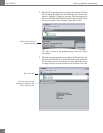
XVC-1001-DC
Guide to installation and operation
34
More advanced de-interlacing techniques include frame-based, motion-
adaptive de-interlacing. This is essentially the same technique described
above however, by using a simple motion calculation, the video processor
can determine when no movement has occurred in the entire picture. If
nothing in the image is moving, the processor combines the two fields
directly. With this method, still images can have the complete 1080 lines
of vertical resolution, but as soon as there is any motion, half of the data
is discarded and the resolution drops to 540 lines. So, while static images
look sharp, moving images does not.
The most advanced de-interlacing techniques available are pixel-based
and motion-adaptive. With this type of processing, motion is identified
at the pixel level rather than the frame level, discarding only the pixels
that would cause combing artifacts and displaying everything else at full
resolution. Pixel-based motion-adaptive de-interlacing avoids artifacts in
moving objects and preserves full resolution of non-moving portions of the
screen even if neighbouring pixels are in motion.
Downconverter
An upconverter converts video with a higher picture resolution to one
with a lower definition. Typically, it refers to taking programming in high-
definition (1080i or 720p) and making it into standard definition (480i
or 576p). Converting high-definition video to standard definition video
involves resizing an image to contain as much as six times less the
number of pixels it had originally. This is done through interpolation, which
discards pixels that aren’t needed to render the lower resolution image.


















